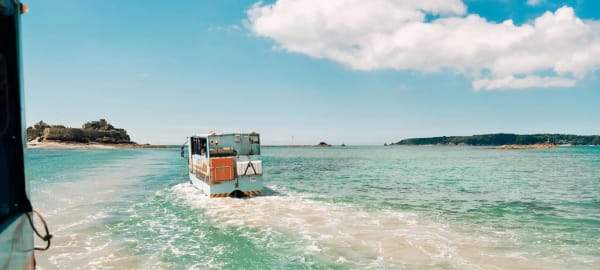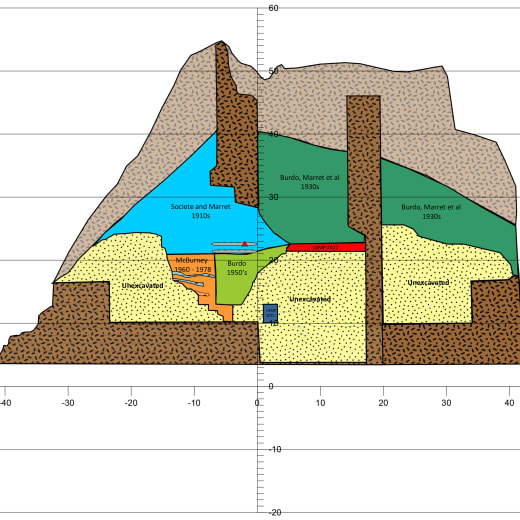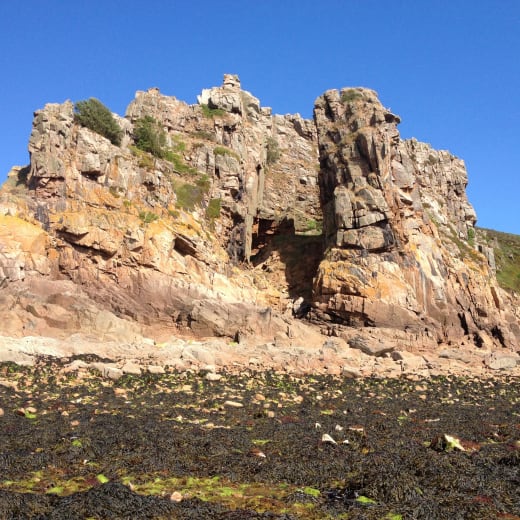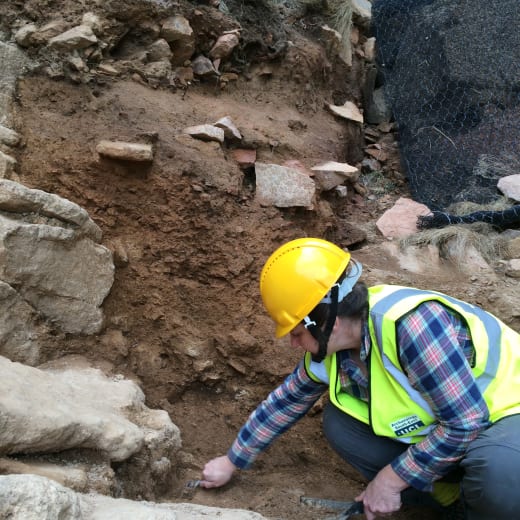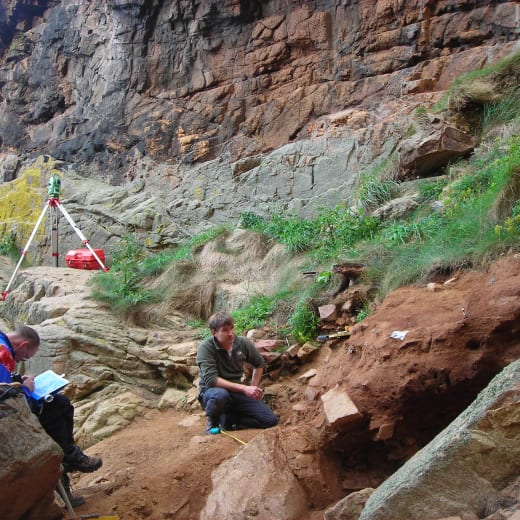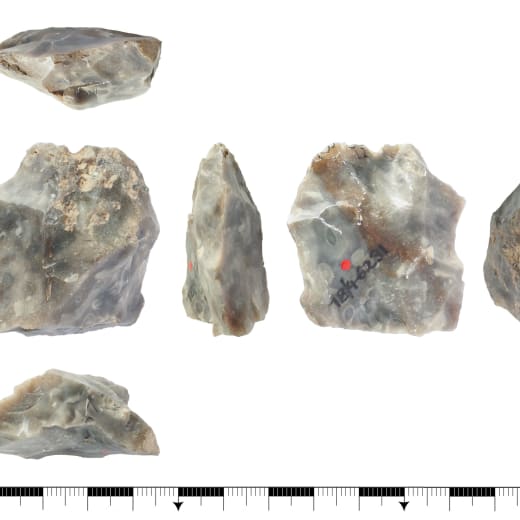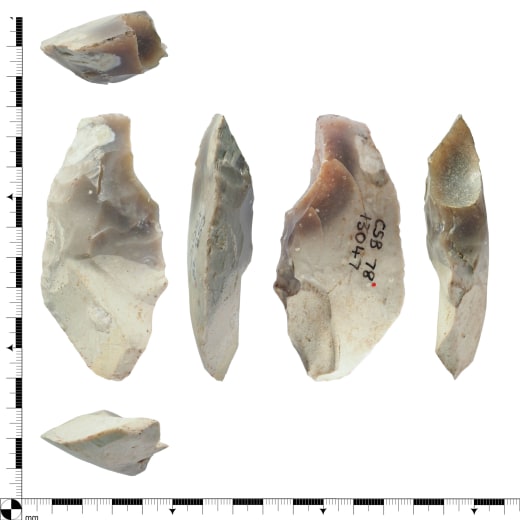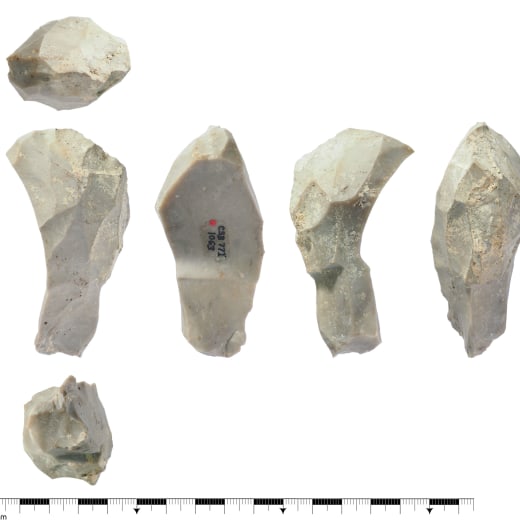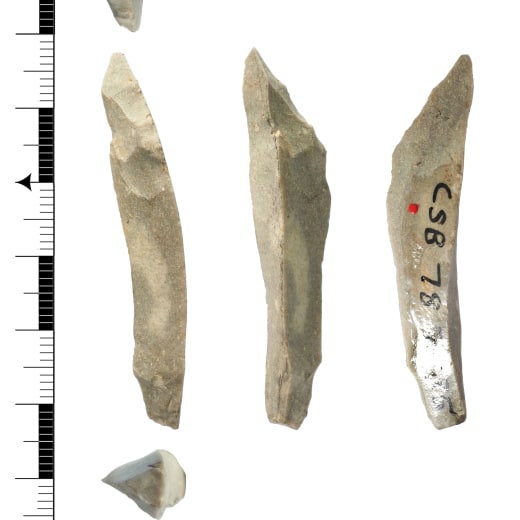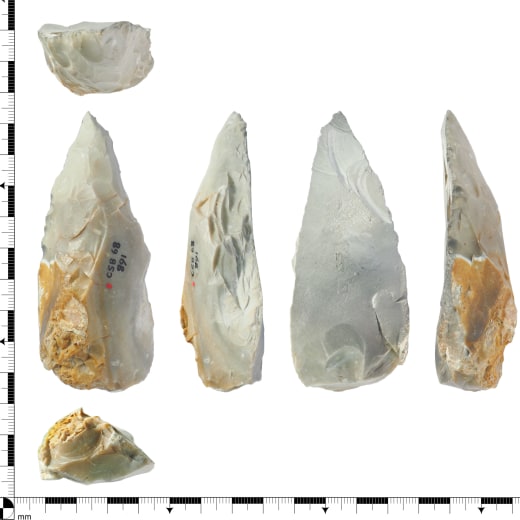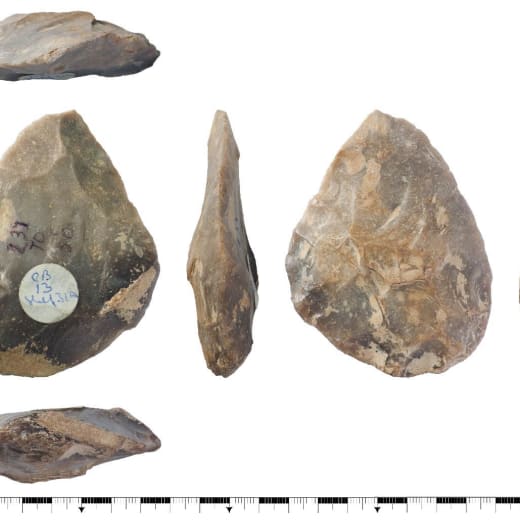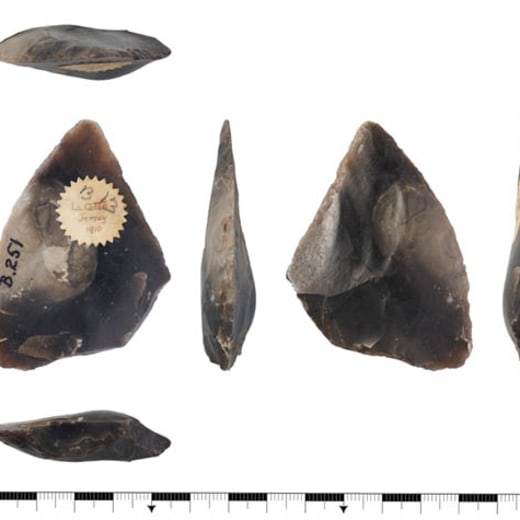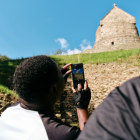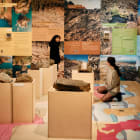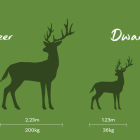
Through a fissure in the rock face, archaeologists found a time capsule, a paleolithic (or early Stone Age) site that contains 250,000 years of evidence of human life in Jersey
At La Cotte de St Brelade (La Cotte) in Jersey, appearances are deceptive. It looks to be a rocky, steep outcrop with its broad feet planted in the sea. But, through a fissure in the rock face, archaeologists found a time capsule, a paleolithic (or early Stone Age) site that contains 250,000 years of evidence of human life in Jersey. Because of the shape of the rock, deposits and sediment were protected, leaving great stratigraphy (layers of geological material) behind for archaeologists to discover.
Although the name La Cotte means ‘the cave’ the site is actually a ravine – a deep steep-sided valley which cuts right through the granite headland at Ouaisné, St Brelade. The ravine was filled with deposits 40 metres thick that built up over a quarter of a million years. Excavation of these different layers produced over 200,000 stone tools including remains of Jersey’s first people – Neanderthal hunters-gatherers. The layers of La Cotte provide us with valuable information about the changing Ice Age environment and Jersey’s earliest people; how they lived, the tools they made, and how they used the natural landscape to help them hunt animals for food.
Olga Finch, Jersey Heritage’s Curator of Archaeology, looks after the evidence found at La Cotte. Access to La Cotte is hard for professionals, impossible for the general public. You have to abseil down into the space under controlled conditions, which is expensive and difficult. So, we rely on archaeologists’ interpretation of the evidence found to trigger our imaginations, to tell us how we lived. As Olga says, each of the layers in the cave give archaeologists a different snapshot of history: ‘Some of the layers will have evidence of their (Neanderthals) lives – their tools, the animals that they hunted. Then there’ll be other layers from times when Jersey wouldn’t have been inhabited but you’ll get environmental information in those layers. And then there are times when there were animals, but no people.’
La Cotte is one of the oldest archaeological sites on Jersey. Sea levels have risen and dropped several times over the course of millennia. A drop in sea level of 11 metres was enough to join Jersey to France, and the Island became a rocky outcrop in the middle of a vast coastal plain left by the retreat of the sea. Now people could walk across from France following herds of animals as they migrated. Stone tools were found at La Cotte as far back as 1881, which led to a series of formal excavations of the site over the following centuries. The earliest modern, scientific approach to examining the site came with a group of Cambridge archaeologists who excavated for a number of years in the 1960s and 70s (and who were joined, at one point, by Prince Charles). They found evidence of mammals – a pile of bones and teeth belonging to nine woolly mammoths and a woolly rhinoceros.
And for ten years now, a team of archaeologists – the Ice Age Island team led by Dr Matt Pope (UCL Institute of Archaeology) and Dr Beccy Scott (The British Museum) – have been coming and going from La Cotte and other prehistoric sites on Jersey. The site has now been made stable to allow extensive new work to go ahead safely and in the summer of 2022 the team returned and will be working on the site for the next three years. As Olga says, the idea is to stay one step ahead of sea erosion, to examine the archaeology before ‘the sea washes it away.’
La Cotte has provided exceptional early fossil evidence for Neanderthal people on Jersey, as Olga explains: ‘It was a strategically important spot for them, they could watch out for woolly mammoths and rhinoceros, and shelter from cold arctic winds. La Cotte really brings alive just how sophisticated and how organized they were and what great communicators – rather than people’s ideas of their being just grunting cavemen.’ We also now have records of Neanderthal’s use of fire, and heaps of bone which showed how they would work together to hunt their food. on. Nothing of an animal was wasted, hunters could make needles, awls and spear tips from animal bones. The sinews, gut and tendons were used to bind stone tools to wooden hafts. The stomach became a useful bag for carrying blood or water. The fat may have been used to waterproof skin boots and other clothing. Grease may have been smeared over the skin to insulate against the cold or to protect the skin from biting insects. Lamps made of fat may have been used within the caves. Horse hair, which has strong fibres, could be twisted together to make thread for sewing clothes or stringing beads and pendants. Animal skins were used to make bags and rucksacks as well as clothes, shoes, sleeping bags and tents. And although part of their diet was made up of the plants, nuts, fruits, berries, birds’ eggs and snails that could be gathered easily, analysis of Neanderthal bones has shown extremely high levels of carbon and nitrogen, suggesting that up to 85% of their diet was meat-based.
‘Although there are other sites on Jersey where ice age objects have been found, La Cotte is of international significance because of the quality and the quantity of material found there, and because of the long unbroken 250,000 year sequence offered by the site.’ There are two Neanderthal teeth in our collection at Jersey Heritage, found in 1910. They were thought at the time to be from one individual. But recent research by the Natural History Museum in London has revealed exciting dental developments that those early archaeologists could not have found. ‘They have told us that there are two individuals, probably male. But most importantly that the teeth show some elements that look like modern human teeth, which wouldn’t normally be found in a Neanderthal tooth. This suggests there was interbreeding between Neanderthal’s and the first early humans, which we had suspected but had no evidence for.’
The particular geography of La Cotte offered shelter at times when much of the channel sea bed was dry land and exposed to dust-laden winds from the barren lands near the ice sheets. This attracted humans and resulted in dense archaeological layers, full of history for those who know where and how to look for it. As archaeological findings at La Cotte are still being discovered and researched, who knows what we might learn about our early ancestors from the next excavation?
Coastal Neanderthals at La Cotte
Small core of flint from which flakes have been removed in an organised way to prepare the core for removing useful flakes from its surface. This method, known as Levallois technique, is used reguarly in some of later levels at La Cotte, but is much rarer in earlier occupation episodes. This core is special because is comes from Layer H , the earliest period of Neanderthal habitation so far identified at La Cotte. It dates to a warm period, known as MIS 7, maybe as much as 240,000 years ago, Jersey was not yet an island, but a peninsula surrounded by high-sea levels. Woodland including oak, hazel and elm surround La Cotte.
Neanderthals Adapting to a Cooling Climate at La Cotte
A flake modified along one edge to create a tool with a convex scraping surface. This relatively large flake, from Layer E, has been further modified to thin the back of the flake, perhaps to make it slightly easier to hold. It comes from a Layer E, an episode of habitation at La Cotte, rich in flint artefacts preserved in a soil, dated to the start of the cold stage we call MIS 6 around 190,000 years ago. The colder conditions are indicated by the presence of woolly rhinoceros, but some deciduous woodland is still present around La Cotte. A tool like this could have been used to clean hides at the start of the processes of turning them into clothing or parts of tents.
A Knapping failure that reveals Neanderthal technology at La Cotte
A fragment of a Levallois core set up to remove flakes from both ends. This artefact represents a knapping mistake by a Neanderthal tool maker, resulting in the breaking of the core. It’s important to us as it is the only clear evidence we have the production of elongated flakes was being undertaken. The blades could have been used as cutting tools. It comes from Layer A at La Cotte, an episode of repeated occupation of the cave around 180,000 years old leaving behind a rich record of stone artefacts and bone. Animals being butchered at the site include mammoth, woolly rhinoceros, reindeer and red deer. Abundant burnt bone indicates Neanderthal people were living in the cave at this time.
Processing Mammoths with small, specialised tools at La Cotte
A specialised flake removal known as burin spall. This has been expertly driven down the edge of a flake. It was used either to create a pointed working surface, rejuvenate a blunted tool-edge or to be used as a small tool in its own right. This find was made from Layer 3, relating to a period of dramatic climatic cooling during MIS 6 around 170,000 years ago. It is associated a mammoth bone heap. No large cutting tools were found at this level but there was lots of evidence for the use of small tools like this, more suited to processing parts of carcasses rather than the initial stages of butchery. Horse, artic fox and red deer were present in the cold landscape at this time. Pollen indicates an open landscape of willow, grasses and heather, with a few birch and pine trees.
A valued tool, carried to, and discarded, at La Cotte
Thick, elongated point, flaked to create two sharp, convergent sides. One of a a group of similar points from Layer 5. This one shows some damage to the tip which Paul Callow speculated could have been produced from use of the tool as a spear-head. Although possible, it is hard to see how some a thick artefact could have been easily hafted. It appears to be a valued tool, resharpened many times and then thrown away because the edges were too steep and blunt to be useful. The tool was found alongside the upper bone heap, some perhaps it could have been used as part of the butchery of the mammoth carcass. This tool came from a short episode of use of the cave during the MIS 6 cold stage, maybe around 160,000 years ago. Very little pollen from trees was present in this sample, it being dominated by heather and willow, indicating very cool conditions.
A rare biface from La Cotte de St Brelade
Excavated in 1910 during the first of two seasons orgnaised by the Société Jersiaise, this stone artefact comes from layers of Neanderthal occupation which date to between 100,000 and 40,000 years ago, during the last Ice Age. The tool is made on a nodule of relatively high-quality flint, not found naturally in Jersey. It has been shaped on both sides using a soft hammer, perhaps made of antler to produce a cutting tool, held in the hand. Multiple stages of reworking are evident including flake removals to resharpen the tool leading to the twisting of it’s cutting tip. We interpret this as a valued tool, carried for a period of time by a late Neanderthal person before being discarded at La Cotte. Bifaces are a feature of some late Neanderthal cultures, but few are found at La Cotte, further study of the waste flakes from these assemblages might help to show if other valuable tools like this were being reworked, but not thrown away at the site.
A Late Neanderthal processing tool from la Cotte
Excavated in 1910 during the first of two seasons orgnaised by the Société Jersiaise, this stone artefact comes from layers of Neanderthal occupation which date to between 100,000 and 40,000 years ago, during the last Ice Age. The tool is made on high-quality flint, which must have been carried to the site. A boldy struck flake forms the basis of this tool which has then been modified on two sides of the tool, a process we call retouch. The retouch created edges which would not be as sharp as the original flake, but very well suited to processing acivities. This tool could have been used to prepare hide, remove flesh from bones or to process other organic material. Detailed microscopic analysis could shed light on it’s use as well as whether it was hafted, or just held in the hand.
Dr Matt Pope
Dr Matt Pope works for the Institute of Archaeology at UCL, London. He studies early human behaviour and how prehistoric people adapted to changing environments. He is particularly interested in the evolution of human hunting behaviour and the use of landscape. He teaches the archaeology of human evolution and coordinates multidisciplinary field investigation. He is passionate about sharing the results of human origins research and explaining why understanding human adaptation is important to society.
Dr Beccy Scott
Dr Beccy Scott works in the Department of Prehistory and Europe at the British Museum, specialising in the behaviour of early Neanderthals in North West Europe. She is particularly interested in how Neanderthals came to ‘act like’ Neanderthals, using their stone tools to reconstruct how they moved within their landscapes, and modified their environments. Beccy investigates the texture of Neanderthal landscapes beyond river valleys and excavates sites on the upland interfluves of Southern Britain. She has studied Neanderthal technology from Britain, Northern France and Belgium, as part of the AHOB projects, and is the author of ‘Becoming Neanderthals’.
We know it is one of the most important Ice Age sites in Europe, but we don’t yet know all the secrets it holds. This project has the potential to surprise us with incredible new stories.
In 2010, the Ice Age Island team began to survey La Cotte de St Brelade, determining both that the site contained further Neanderthal archaeology and that it was under threat from significant coastal erosion. Since then, we have worked with the Société Jersiaise and engineering teams from the Channel Islands and UK to transform the site into a place that is both safe to work in and secure from further damaging erosion. The engineering project represents a bold and innovative response to the effects of sea level rise and climate change and provides an opportunity to safeguard an internationally important scientific record.
The return of the archaeologists was only possible after the cliffs above were made safe and the site was protected from the sea. The sea wall has been designed to protect the site from sea level rise and storm events during the next few decades, and this will give us time to discover more about this internationally important record of Neanderthal archaeology and leave the site intact or future generations to make their own discoveries.
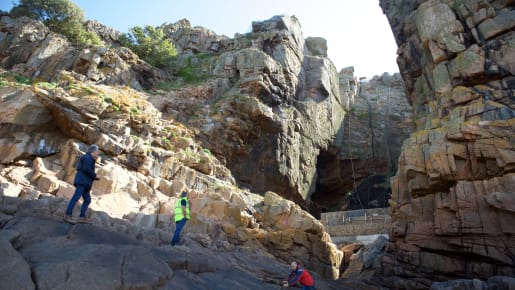
The sea wall shown on the right by Dave Ferguson at the Jersey Evening Post
Working on a part of the site that hasn’t been accessible for over a generation years, we’ve been able to begin to detailed, scientific excavation, recovering scientific dating samples and finding artefacts made from flint and quartz. The excavations are part of a long-term plan for stabilising the West Ravine and the team are now taking on this this complex and massive site, bringing it under new investigation and preserving it for the future.
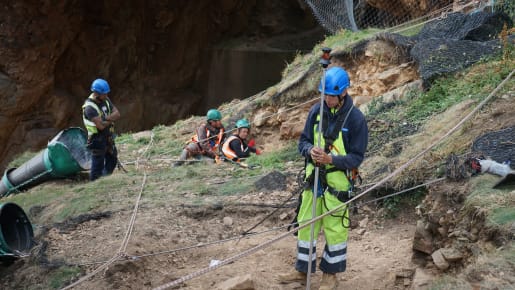
Working on site on the West Ravine
In July 2022, we announced that The former Prince of Wales had become Patron of this important restoration project to protect and preserve the ancient site of La Cotte de St Brelade. At the time, Jonathan Carter, Chief Executive of Jersey Heritage, said: “We are incredibly grateful to The Prince of Wales for accepting our invitation to become Patron of Jersey Heritage’s La Cotte de St Brelade Archaeological Project and are sure the news will be a tremendous boost to gathering interest in, and support for, the next crucial stage of this important project.

His Royal Highness The former Prince of Wales at Highgrove by Hugo Burnand
History
The Coin Hoard comes home
The story of Le Câtillon II, the largest hoard of Iron Age gold and silver coins, jewellery and ingots ever found in Western Europe.
History
Claude Cahun and Jersey
Claude Cahun (1894-1954) was an artist, photographer and writer. She is best known today for her surreal self-portrait photographs.
Places to Visit
La Hougue Bie
A peaceful and ancient site where you can visit one of the oldest buildings in the world.
Places to Visit
Jersey Museum, Art Gallery & Victorian House
In the heart of St Helier you’ll discover the story of Jersey.
History
Dwarf Red Deer
Jersey Heritage has some rather unusual red deer bones on display at Jersey Museum.


